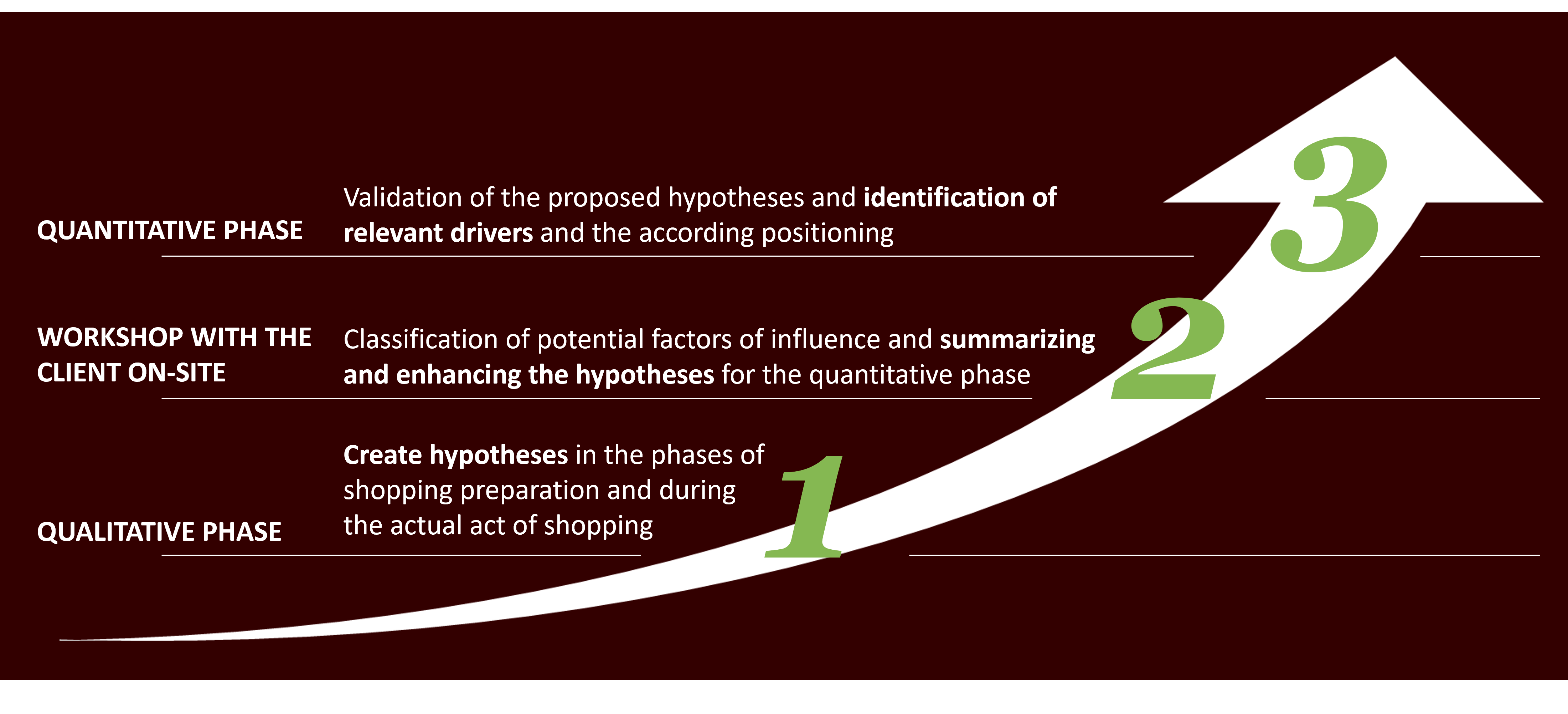Shopper Research
The decision-making processes of shoppers are multi-layered. Explicit motives are relevant, but to a much higher extent they are driven by implicit motives.
To be able to present the decisive impulses at the POS with your brand, to stand out and convince, you need to understand the consumer behavior and the motives underneath.
Shopper marketing often is confronted with the following issues:
- How is your brand perceived in the competitive environment at the POS?
- Is the product placing optimal?
- Is the product presentation appealing?
- Is your brand considered to be relevant?
- Are the important criteria communicated in a catchy and clear way?
- What drivers and barriers take effect with the purchase?
The issues of retailers are different in parts:
- What influences the decision where to shop?
- How can we increase our relevance as a ‘first stop’?
- How can the shopping experience be improved?
nuggets offers consulting which research approaches will generate the right shopper insights to help you solve your issues regarding the optimization of your POS strategy.
Customer Journey – the customer’s path to your brand
Whether it is services, insurance policies, travel or durable consumer goods – the path of the consumer to the product hardly ever is a direct one. Searching for information on- and offline, social media, mass communications – the touchpoints with the customer are manifold. For many aspects of shopper marketing it is important to comprehend the path and to understand what path the customer took to get to your brand. Because the customer journey provides a lot of options to your shopper marketing to pick the customer up in his current state of mind and to get him enthusiastic about your own brand.
Tracing a customer journey can be done with the help of various methods. The great challenge is that our research must not influence the customer journey. It also should be affordable and it should be possible to conduct it within a reasonable time frame. How this can be achieved by us, mainly depends on your field of business and the objectives of the research.
nuggets has developed a framework for customer journey studies in the field of consumer goods and retail – outlined below – which often is appropriate to answer the relevant questions efficiently and quickly.

Shopper Research_EN
Many more additional modules can be used in the context of a customer journey but also for less comprehensive issues. Some of these we would like to briefly introduce to you.
Accompany your customer when he is shopping
Where to better observe customer behavior than directly on the POS? Many questions regarding the topic shopper research – especially with fast moving consumer goods/ FMCG – can be answered with accompanied shopping. Here, we first observe the behavior of the shopper and then challenge it with an in-depth interview afterwards. An interview before the accompanied shopping is possible, too.
That way, we explore the precise moment when a decision in favor of or against your brand is made.
If required, eye tracking can be used with the shopping as well. The analysis of the eye movements helps us to analyze in even more detail and more precisely which are the eye-catchers at the POS and where the stopping power is highest.
Not only for brand manufacturers, but also for retailers accompanied shopping can provide valuable information. For example, on the perception of your own store design, the arrangement of goods and the shopping atmosphere.
Directly after shopping
Sometimes an interview promptly after shopping is required to gather fresh and undistorted impressions of the purchase. With brief face-to-face interviews, we gather KPIs on the shopping experience in a direct temporal context.
Among other situations, POS surveys are reasonable if the objective is the measurement of perception, for example secondary placings, displays, POS advertising or promotion activity.
Decentralized and flexible in terms of time
If we want to put the consumer in the position to participate in surveys anytime and anywhere, we use mobile research. With this, they get available at the POS as well as at almost any other point of the customer journey. Via an app, they can answer questions right at the moment of truth. Also, tasks can be sent to the participants via push messaging.
Your brand on the shelf
Certain study designs cannot be implemented on the real POS at a reasonable effort. For example, package dummies with a new pack design cannot be tested in a real retail store. Questions on category management, for example on the right placement of a product on a shelf, can be answered much easier and more efficient in an artificial test environment.
For these studies, we recreate the shelf environment of the product as close to reality as possible – in a test studio with a classic shelf test or virtually for an online survey at the computer. That way, a purchase decision can be comprehended with comparatively little effort with a large sample.
Further information on the shelf test can be found under packaging test and shelf test.
Purchase drivers and barriers
For shopper marketing, it often is helpful to have a precise knowledge of the shopper types you are dealing with and which of them are most likely to be responsive to your own brand. At this point a quantitative shopper segmentation will be helpful, which can be the basis for a much more efficient shopper marketing.
Sales drivers and barriers can be determined within the scope of such a quantitative shopper study as well. That way, we show which dimensions of the shopping experience are really decisive for sales.

Do you have questions?
We look forward to your message!







































